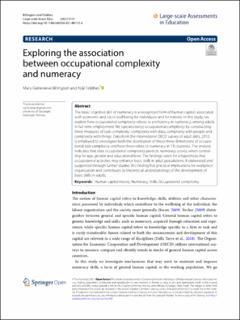| dc.contributor.author | Billington, Mary Genevieve | |
| dc.contributor.author | Foldnes, Njål | |
| dc.date.accessioned | 2021-10-21T13:33:37Z | |
| dc.date.available | 2021-10-21T13:33:37Z | |
| dc.date.created | 2021-09-02T12:12:01Z | |
| dc.date.issued | 2021-09 | |
| dc.identifier.citation | Billington, M.G., Foldnes, N. (2021) Exploring the association between occupational complexity and numeracy. Large-scale Assessments in Education, 9, 19 | en_US |
| dc.identifier.issn | 2196-0739 | |
| dc.identifier.uri | https://hdl.handle.net/11250/2824563 | |
| dc.description.abstract | The basic cognitive skill of numeracy is a recognized form of human capital, associated with economic and social well being for individuals and for nations. In this study, we explore how occupational complexity relates to proficiency in numeracy, among adults in full-time employment. We operationalize occupational complexity by constructing three measures of task complexity: complexity with data, complexity with people and complexity with things. Data from the international OECD survey of adult skills, 2012, is employed to investigate both the distribution of these three dimensions of occupational task complexity and how these relate to numeracy in 13 countries. The analysis indicates that data occupational complexity predicts numeracy scores, when controlling for age, gender and educational level. The findings open for a hypothesis that occupational activities may enhance basic skills in adult populations. If elaborated and supported through further studies this finding has practical implications for workplace organization and contributes to theoretical understandings of the development of basic skills in adults. | en_US |
| dc.language.iso | eng | en_US |
| dc.publisher | Springer Nature Switzerland AG | en_US |
| dc.rights | Navngivelse 4.0 Internasjonal | * |
| dc.rights.uri | http://creativecommons.org/licenses/by/4.0/deed.no | * |
| dc.subject | utdanningsvitenskap | en_US |
| dc.subject | tallforståelse | en_US |
| dc.title | Exploring the association between occupational complexity and numeracy | en_US |
| dc.type | Peer reviewed | en_US |
| dc.type | Journal article | en_US |
| dc.description.version | publishedVersion | en_US |
| dc.subject.nsi | VDP::Samfunnsvitenskap: 200::Pedagogiske fag: 280 | en_US |
| dc.source.volume | 9 | en_US |
| dc.source.journal | Large-scale Assessments in Education | en_US |
| dc.identifier.doi | 10.1186/s40536-021-00112-6 | |
| dc.identifier.cristin | 1930792 | |
| dc.source.articlenumber | 19 (2021) | en_US |
| cristin.ispublished | true | |
| cristin.fulltext | original | |
| cristin.qualitycode | 1 | |

